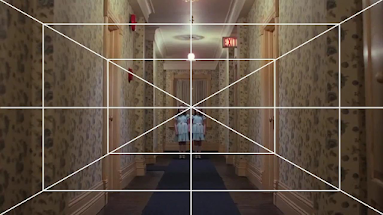Kubrick One-Point Perspective
Hi! After reading chapter 2 the video I picked was Stanley Kubrick and his use of one-point perspective.
In the reading it talks about composition which is the arrangement of people, objects, and setting within
the frame of an image. When reading this I thought back to myself also doing this when I am taking
photos and never realized that what I was actually doing was called composition. Filmmakers that
master this technique are able to then use composition to help tell their story. Many filmmakers use
composition to tell their story through repetition. In Kubrick's film you were able to see this unfold being
that he would go back and repeat the same locations throughout the course of the film. The film also gradually speeds up which made
things more dramatic and also included having people in the center of the frame. Kubrick also included some of the people in different frames doing the same motion repeatedly. I enjoyed this short video
because it was so intense and also caught my attention with everything that was going on.
In the chapter 2 reading some things that stood out to me was when they were speaking about
cinematic language. This is important because this is the way cinema communicates meaning to
viewers. Filmmakers have worked together to develop visual lexicon which is a shared sets of
meaningful units in our collective cinematic language through images, angles,
transitions, and camera moves. As movie watchers we are not supposed to pay that much close
attention to these details because these details should just flow into everyday life perspective.
Literature helps build up certain moments in a film, which we distinguish between explicit and implicit
meaning. Explicit meaning is the directly expressed meaning of a work of art while implicit meaning is
the deeper essential meaning , that is suggested but not necessarily directly expressed. Films that
cover implicit meaning are moving to watch being that you have to see the bigger picture, even when
not directly told.
https://www.youtube.com/watch?v=flq0t4jrqJQ&t=1s




Hi Ellenie! I remember taking a photography class where we learned about one-point perspective. I think we all unknowingly use it when we take pictures but it is interesting to learn about it in the context of film because there is the added element of movement and actors that can't be done with pictures.
ReplyDeleteYes to this! WE know so much about images and film. When we mix is complex stories and meanings, we "forget" the rules and just immserve ourselves.
DeleteHi Ellenie, I watched the same video and I agree with you that it draws the attention of the viewer very well. I couldn't look away because it was like the filmmaking was drawing me in and the suspense was great. While I've never done any photograph classes it does remind me of museum artwork where they want your attention to the vanishing point or somewhere in the distance.
ReplyDeleteHi Dakota, thanks for responding! I am glad to hear that you also enjoyed this same film as me and thought the same thing! That is also true about museum artwork also doing the same thing.
Delete